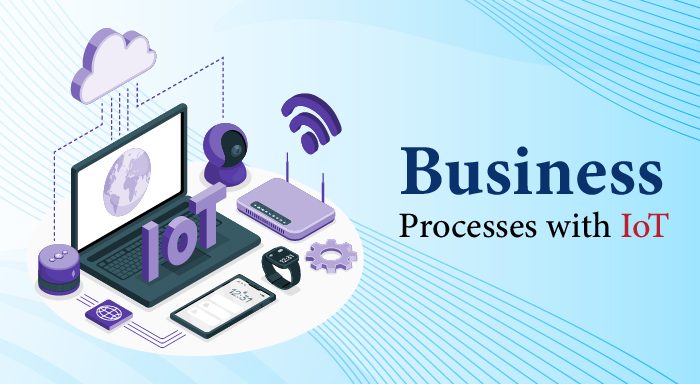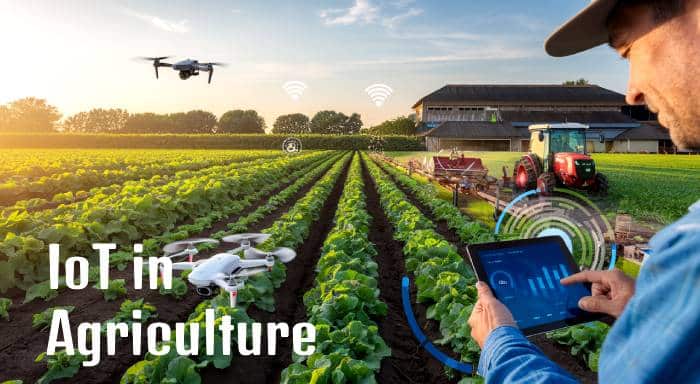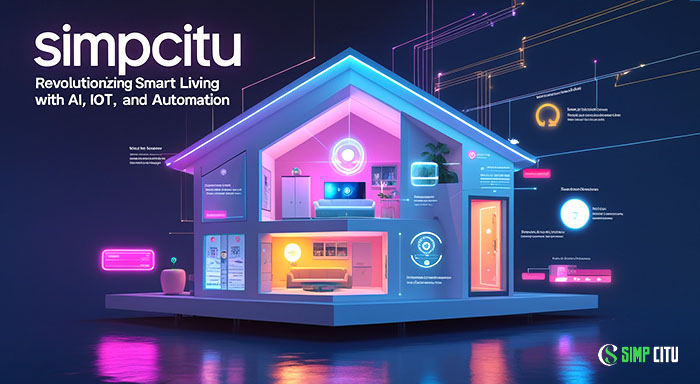Introduction
The advancement of IoT as a technology has accelerated tremendously, catalyzing technological disruption which has impacted several industries' operations, productivity, and innovation. To sum it up, for businesses, recognizing and managing how to utilize business processes with IoT to enhance operational settings has ceased to be an advantage but a necessity for firms.
This blog delves into how IoT reshapes business processes, the critical steps to integrate IoT and its transformative benefits.
Understanding IoT in Business
IoT stands for Internet Of Things and can be described as a system of tangible physical devices according to communication protocols in IoT, that are equipped with sensors, software as well as other related technologies so that they can communicate and gather data.
From a business perspective, IoT can join equipment, vehicles, and any other business assets to a system to monitor the function of this equipment or vehicle as well as other assets, making decisions, and optimization of operations. Many companies are now partnering with device as a service providers to streamline the deployment and management of IoT-connected hardware, ensuring seamless integration, regular maintenance, and secure device lifecycle management.
Additionally, businesses looking to collect and process massive amounts of data generated by IoT devices can benefit from a web scraping solution to efficiently extract and analyze this information, further enhancing decision-making and operational strategies.
Key Business Processes Impacted by IoT
1. Supply Chain Management
IoT will improve the transparency of the supply chain by tracking and monitoring physical assets or goods in real-time from the time they are manufactured to the time they are delivered to the consumers. Retail supply chain management software leverages these IoT technologies to provide businesses with real-time insights into inventory levels, shipment conditions, and delivery routes. These technologies can notify the firms about the status of raw materials or finished products, the conditions under which they are shipped, or the routes they take, which in return assists the firms in predicting customer needs more accurately, cutting costs, and reducing possible risks like theft.
2. Predictive Maintenance
This means that various IoT devices help in the tracking of the health of various machines and equipment in terms of potential breakdowns or even failures. Such maintenance anticipates asset failure and aims at avoiding it, and in the process, minimizes the time when such an asset is unavailable, creating longer life, and efficient operation.
For example, manufacturers can use the IoT sensors to take note of certain problems within industries and arrange for maintenance at the right time thus reducing the incidence of expensive repair and production breakdowns.
3. Energy Management
IoT solutions assist in saving energy by analyzing energy utilization and determining wastage levels. They also assist in monitoring energy consumption by using smart technology such as smart meters and connected devices to cut down the expenses incurred on energy bills and the usage of energy appliances.
For instance, in a smart building, light and heating ventilation air conditioning systems can be controlled according to the presence of people and weather and this greatly reduces energy expenses.
4. Customer Experience
IoT can dramatically change the world of customer interactions through timely and personalized services. IoT-enabled devices are widely employed in the retail industry to collect consumers' information, monitor their behavior, and improve shopping experiences. Additionally, having mobile XR solutions can enhance immersive experiences, providing more interactive ways to engage with customers.
Some examples of intelligent capabilities include; Smart shelves for example can inform the staff that certain products are almost out of stock and also inform the customers of the real-time stock status.
Also Read
Internet of Things (IoT) Enabling Technologies
IoT Device Management: Definition, Need, and Mechanics
History of IoT: Analyzing the Origins of IoT
Steps to Integrate IoT into Business Processes
1. Define Objectives
Determine the precise business goals that are to be met through the use of the IoT. Whether it is making a business more efficient, saving on expenses, or increasing customer satisfaction, goals will shape your IoT initiative.
2. Conduct a Feasibility Study
Assess the practicality of adopting IoT from a technical parameter and cost analysis perspective. These are factors such as the current state of the facilities, cost, and the return on investment. Awareness of the level of IoT readiness in your business is also important as it shall assist in effective implementation.
3. Selecting an IoT platform
Choose the IoT platform that is most suitable for your business. It has to incorporate features that deal with the connectivity of devices, and both storage/retrieval of data and analysis. Make sure that it can be expanded over time and is encrypted with smooth compatibility with other databases.
4. Develop a Pilot Project
The first approach is to initiate the pilot project that addresses the IoT level implementation on a small scale and in a restricted area of the organization. This makes it possible for one to know the likely success, and the potential difficulties as well as plan how to deal with them if the project is to be expanded to a full scale.
5. Evaluate Data and Clean Research
This coinciding of two trends has led to the emergence of the Internet of Things, which produces huge amounts of data. Take advantage of high-level data analyses to drive innovations, optimize strategies, and enhance decisions. That is why Io forefronts benefit from constant monitoring and analysis of the networks.
Advantages of IoT to Business Procedures
1. Enhanced Operational Efficiency
Functional blocks of IoT facilitate automation of the process and real-time control over the activities to be performed thus avoiding the errors that are likely to occur due to interferences. This results in improved efficiency in the organization due to the enhancement of efficiency in the processes being followed.
For instance, in the manufacturing industry, IoT technology may enable an assembly line to run without frequent human intervention, as it produces goods 24/7.
2. Cost Savings
Through proper utilization of resources and time and proper policy and maintenance, IoT can indeed reduce expenses significantly in various fields of business. Effective energy management systems, activities like predictive maintenance, and improved logistics are other ways through which a great deal is saved. A logistics firm can cut the costs of fuel since IoT makes it easy to monitor delivery routes and increase the time taken to make deliveries.
3. Improved Decision Making
Remote data as a result of IoT tells the exact real-time information to the organizations, thus making proper decision-making. Thus, this integrated and data-driven approach strengthens strategic planning and operational responsiveness. With this kind of system, retailers are capable of changing the inventories within a short time according to the flow of sales hence satisfying customers.
4. Better Customer Insights
IoT devices collect valuable customer data, offering insights into behavior, preferences, and trends. Businesses can leverage this information to personalize offerings, enhance customer experience, and drive loyalty. A connected car, for instance, can collect data on driver habits and preferences, enabling automotive companies to offer personalized services and maintenance reminders.
5. Enhanced Security
IoT devices improve security by providing real-time surveillance and monitoring of assets. Smart security systems can detect and respond to threats, reducing the risk of theft or damage. In a warehouse setting, IoT-enabled cameras and sensors can monitor entry points, alerting security personnel to unauthorized access or suspicious activities.
Challenges and Considerations
1. Security Concerns
IoT devices increase the number of entry points for potential cyberattacks. Ensuring robust security measures, such as encryption and regular updates, is essential to protect sensitive data.
2.Trust Management Platform
To further bolster IoT security, businesses should consider deploying a trust management platform. These platforms handle digital identity verification process, access permissions, and secure authentication protocols across connected devices and users. In an IoT ecosystem where multiple stakeholders (devices, employees, partners) interact with sensitive data and systems, trust management platforms ensure only authorized entities gain access—minimizing the risk of breaches and unauthorized control. Implementing such a platform can be a crucial step toward building a secure, scalable IoT infrastructure.
3. Data Management
The sheer volume of data generated by the access control of IoT devices can be overwhelming. Efficient data management practices, including storage, processing, and analysis, are crucial for leveraging IoT effectively.
4. Interoperability
Different IoT devices and platforms may not always be compatible with each other. Ensuring interoperability and seamless integration with existing systems is vital for a successful IoT implementation.
Future of IoT in Business Processes
The future of IoT in business processes looks promising, with advancements in technologies such as artificial intelligence (AI), machine learning (ML), and 5G connectivity. These developments will further enhance IoT capabilities, enabling businesses to achieve even greater levels of efficiency, innovation, and customer satisfaction.
With AI and ML, IoT devices can learn from data patterns and make autonomous decisions, driving smarter operations. 5G connectivity will provide faster data transfer rates, lower latency, and the ability to connect more devices, unlocking new possibilities for IoT applications.
Conclusion
IoT is revolutionizing business processes by enabling real-time data collection, automation, and enhanced decision-making. From supply chain management to customer experience, IoT offers transformative benefits that can drive efficiency, reduce costs, and foster innovation. By strategically integrating IoT and overcoming challenges such as security and data management, businesses can position themselves at the forefront of the IoT revolution and achieve sustainable growth.
transform your business processes with IoT and stay ahead in the competitive landscape. The time to adopt IoT is now, unlocking untapped opportunities and paving the way for a smarter, more connected future.



